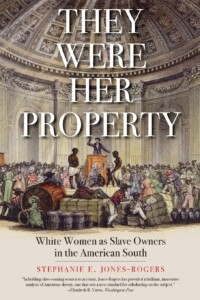They Were Her Property: White Women as Slave Owners in the American South by Stephanie E. Jones-Rogers (2019), 296 pages.
(ebook on Libby from the Indiana Digital Library)
(eAudiobook on Libby from the Indiana Digital Library)
For many Americans who have studied the history of chattel slavery in the United States, there is a common image of only white men as slaveholders, with white women as barely involved in the practice, being wholly economically dependent on their husbands and other male relatives. Whether this common belief is due to an understanding of the past legal doctrine of coverture, wherein married women had no independent legal existence apart from their husbands, or whether the idea of Southern white women’s innocence in relation to the institution of slavery has been deliberately promoted since the Civil War is hard to say. Regardless, the historian Stephanie E. Jones-Rogers makes a strong case in They Were Her Property: White Women as Slave Owners in the American South that this image of innocent and uninvolved white women is entirely false based on the historic record.
This book is an extensively researched and meticulously argued work of scholarship that goes beyond more commonly used primary sources such as letters and personal documents from slaveowners themselves to look directly at court records, newspaper advertisements, and other primary sources from the time period. Even more powerfully, Jones-Rogers quotes from formerly enslaved people themselves, using recorded interviews conducted by the Federal Writers’ Project (part of the WPA of the 1930s and 40s). Jones-Rogers makes a strong argument that enslaved people had a sophisticated and nuanced understanding of the dynamics of the households in which they were enslaved, this dynamic often being a matter of life or death for them. These enslaved people knew who legally owned them and who had power over them – to collect the profit of their labor, to sell them or hire them out, and to punish them for alleged misdeeds. As a result of this evidence, Jones-Rogers is able to show that many Southern white women were in fact and in practice the actual legal owners of enslaved human beings and in many cases took pains to make sure their slaves were their “sole and separate property” apart from their husbands and other male relatives. Since women did not generally own their own land at the time, these enslaved people were often the majority of a woman’s personal wealth.
Though this book can be dense with evidence and references to specific sources, there are still specific personal stories from the past that leap off the page. Some are stories of unimaginable cruelty and violence and others are stories of mercy, tempered with the understanding that such compassion from a slaveholding woman towards her enslaved human property had an economic incentive behind it that was not entirely altruistic. I found this book to be truly eye-opening, especially as a white woman, and I appreciated the opportunity to hear a more real version of American history, backed by strong historical evidence and the personal stories of direct survivors of slavery.
Looking for a similar book? Here are some suggested readalikes:
Eighty-Eight Years: The Long Death of Slavery in the United States, 1777-1865 by Patrick Rael (2015), 392 pages.
The Half Has Never Been Told: Slavery and the Making of American Capitalism by Edward E. Baptist (2014), 498 pages.
Of Blood and Sweat: Black Lives and the Making of White Power and Wealth by Clyde W. Ford (2022), 405 pages.

